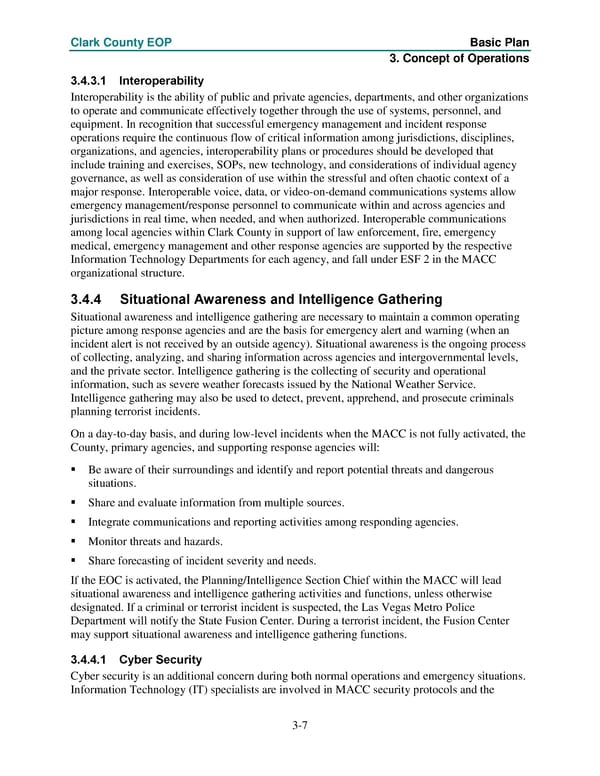Clark County EOP Basic Plan 3. Concept of Operations 3.4.3.1 Interoperability Interoperability is the ability of public and private agencies, departments, and other organizations to operate and communicate effectively together through the use of systems, personnel, and equipment. In recognition that successful emergency management and incident response operations require the continuous flow of critical information among jurisdictions, disciplines, organizations, and agencies, interoperability plans or procedures should be developed that include training and exercises, SOPs, new technology, and considerations of individual agency governance, as well as consideration of use within the stressful and often chaotic context of a major response. Interoperable voice, data, or video-on-demand communications systems allow emergency management/response personnel to communicate within and across agencies and jurisdictions in real time, when needed, and when authorized. Interoperable communications among local agencies within Clark County in support of law enforcement, fire, emergency medical, emergency management and other response agencies are supported by the respective Information Technology Departments for each agency, and fall under ESF 2 in the MACC organizational structure. 3.4.4 Situational Awareness and Intelligence Gathering Situational awareness and intelligence gathering are necessary to maintain a common operating picture among response agencies and are the basis for emergency alert and warning (when an incident alert is not received by an outside agency). Situational awareness is the ongoing process of collecting, analyzing, and sharing information across agencies and intergovernmental levels, and the private sector. Intelligence gathering is the collecting of security and operational information, such as severe weather forecasts issued by the National Weather Service. Intelligence gathering may also be used to detect, prevent, apprehend, and prosecute criminals planning terrorist incidents. On a day-to-day basis, and during low-level incidents when the MACC is not fully activated, the County, primary agencies, and supporting response agencies will: Be aware of their surroundings and identify and report potential threats and dangerous situations. Share and evaluate information from multiple sources. Integrate communications and reporting activities among responding agencies. Monitor threats and hazards. Share forecasting of incident severity and needs. If the EOC is activated, the Planning/Intelligence Section Chief within the MACC will lead situational awareness and intelligence gathering activities and functions, unless otherwise designated. If a criminal or terrorist incident is suspected, the Las Vegas Metro Police Department will notify the State Fusion Center. During a terrorist incident, the Fusion Center may support situational awareness and intelligence gathering functions. 3.4.4.1 Cyber Security Cyber security is an additional concern during both normal operations and emergency situations. Information Technology (IT) specialists are involved in MACC security protocols and the 3-7
 Emergency Operations Plan Page 49 Page 51
Emergency Operations Plan Page 49 Page 51